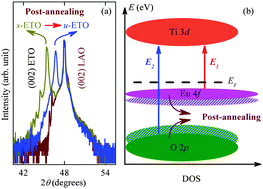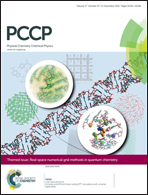Strain and temperature dependent absorption spectra studies for identifying the phase structure and band gap of EuTiO3 perovskite films
Abstract
Post-annealing has been approved to effectively relax the out-of-plane strain in thin films. Epitaxial EuTiO3 (ETO) thin films, with and without strain, have been fabricated on (001) LaAlO3 substrates by pulsed laser deposition. The absorption and electronic transitions of the ETO thin films are investigated by means of temperature dependent transmittance spectra. The antiferrodistortive phase transition can be found at about 260–280 K. The first-principles calculations indicate there are two interband electronic transitions in ETO films. Remarkably, the direct optical band gap and higher interband transition for ETO films show variation in trends with different strains and temperatures. The strain leads to a band gap shrinkage of about 240 meV while the higher interband transition an expansion of about 140 meV. The hardening of the interband transition energies in ETO films with increasing temperature can be attributed to the Fröhlich electron–phonon interaction. The behavior can be linked to the strain and low temperature modified valence electronic structure, which is associated with rotations of the TiO6 octahedra.


 Please wait while we load your content...
Please wait while we load your content...